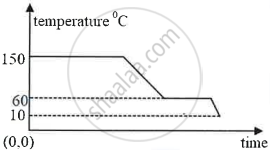Advertisements
Advertisements
प्रश्न
For the same mass of ice and ice-cold water, why does ice produce more cooling than ice-cold water?
उत्तर
For the same mass of ice and ice-cold water, due to the absorption of latent heat by the ice, the ice produces more cooling than ice-cold water.
APPEARS IN
संबंधित प्रश्न
What do you understand by the term latent heat?
Explain the following:
The heat supplied to a substance during it change of state, does not cause any rise in its temperature.
The specific latent heat of fusion of water is ______.
During transformation of liquid phase to solid phase, the latent heat is ______.
Explain the following temperature vs time graph.

Liquid ammonia is used in ice factory for making ice from water. If water at 20°C is to be converted into 2 kg ice at 0°C, how many grams of ammonia are to be evaporated? (Given: The latent heat of vaporization of ammonia = 341 cal/g)
When a liquid is getting converted into solid, the latent heat is ………………………………
Define specific latent heat of vaporization of a substance.
Explain why water is used in hot water bottles for fomentation and also as a universal coolant.
Explain, why no tracks are left on the ice during ice skating?
What do you understand by the ‘latent heat of vaporization’ of a substance?
If pressure increases, the melting point of a substance ______.
During reheating, ice is converted to water at a temperature of 0 °C.
1 kg of dry air at a temperature of 40 °C can hold a maximum of 49 g of water vapour.
Define specific latent heat capacity
Specific latent heat L = ______.
Observe the following graph and answer the following questions:

- What does the graph represent?
- What does the line AB represent?
- What does the line BC represent?
The diagram below shows a cooling curve for a substance:

- State the temperatures at which the substance condenses.
- The temperature range in which the substance is in liquid state.
- Why do we prefer ice to ice-cold water for cooling a drink?
